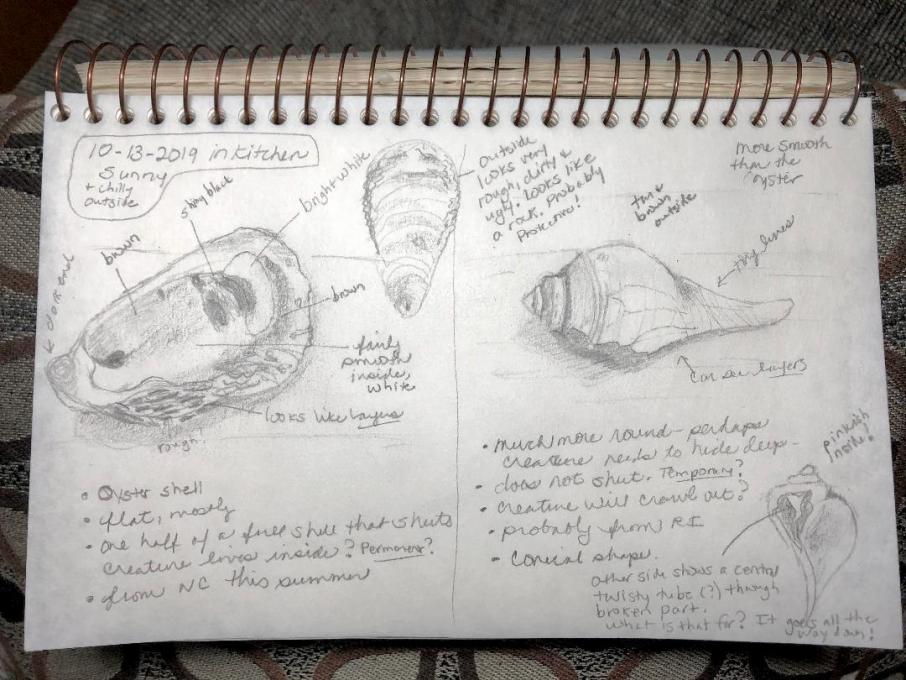The Cornell Lab Bird Academy › Discussion Groups › Nature Journaling and Field Sketching › The Power of Comparison
-
Simple versus Complex. I challenged myself by choosing a rather complex subject to draw, but liked the comparison of two different kinds of seed carriers, a pine cone containing multiple seeds and a hickory nut containing only one seed. I wondered why the pine tree produces so many seeds and the hickory relatively few in comparison. I included the leaves because the hickory has a more complex leaf as compared to the pine.

-
Karen, your rendering of the pine cone has me smiling, as it seems to perfectly encapsulate not only the object itself but also the smells and evocation of this time of year. Lovely! Cheers, Laurie
-
This is so effective and well drawn.
-
-

-
I would have never thought to try to draw individual feathers! I am a bird lover so your drawing (as well as the one who did feathers above this post) have inspired me to try some. I don't have anything as exciting as a road runner feather (how lucky to have that) but I guess I could start with the many crow feathers and pigeon feathers I find. Great idea!
-
-
I decided to work with elements that I found interesting in the lesson. 1) Demo is drawn so fast - I don't trust my skill level so I tend to draw slowly. 2) The details are suggested but not always drawn in detail. 3) ask and muse about answers - I tend to figure someone already has the answer so if I ask, why not look it up... but it could be kind of fun to muse first. I sat in our front yard a bit away from the trees and tried a rough and quick comparison. Nothing fancy, but I was pleasantly surprised at how curious I became about the tree growth and trying to remember anything I know about leaf types (not much) so it could help to do a little research to remember complex and compound vs other leaf types.).

-
1. This is the first time I did a comparison study and I found it to be really helpful. It helped me to observe the differences and similarities and guided some of my observations. I feel that it helped me study to object in more depth, and will help to grow my observation skills. 2. I think this is helpful to from time to time include all this information in my journal. It will help later to identify certain objects and most definitely expand my knowledge of the variety of objects found in nature all around me.
-

-
 I
It rained most of today so I compared these two oak leaves working inside.
One new thing I learned is that not only each lobe had a vessel, but each sub-lobe had one as well. I wondered if the branched "veins" only carried sugars away from the leaf or if nutrients also flow back into the leaf. It seems there are these types of oak species (rounded or pointed lobes), and oaks with no lobes. The leaves reminded me of my own hand, especially the back.
I felt that I need to draw hundreds of leaves before I'll begin to appreciate the structure of leaves, and that's just the leaf! The whole tree. It's an endless journey.
The other student drawings are so interesting!
I
It rained most of today so I compared these two oak leaves working inside.
One new thing I learned is that not only each lobe had a vessel, but each sub-lobe had one as well. I wondered if the branched "veins" only carried sugars away from the leaf or if nutrients also flow back into the leaf. It seems there are these types of oak species (rounded or pointed lobes), and oaks with no lobes. The leaves reminded me of my own hand, especially the back.
I felt that I need to draw hundreds of leaves before I'll begin to appreciate the structure of leaves, and that's just the leaf! The whole tree. It's an endless journey.
The other student drawings are so interesting! -
I'm hoping to be able to simplify my drawing and subject matter like you have done with your comparison study of these two leaves. They are great drawings and look good on your page.
-
-

-
Inspired by the "lecture" and all the wonderful shared comments and pages by fellow students, I still gave it a few days before doing the exercise. I did several hikes the past week and came to realize that even a short walk in my city has me passing dozens of different types of trees and I'm woefully unable to identify more than a few very obvious specimens. Long intro to: I chose trees. Two oaks which are growing across the street from me and are beginning their fall color transition. I never knew their names until today, and the comparison of the leaves, trunk and fruit (nuts) upped my appreciation for the Gift of Nature so close to my very small corner lot backyard. Taking the time to study the leaves, make the comparisons, then draw them and list observations has me feeling like I "got to know my neighbors." A walk around the block was stimulating and challenging. I located one tree ID book I had, and ordered another one right away. Looking forward to the process of learning to ID trees using the methods presented in this course. Hurrah!

-
I keep going back to look at others' work when new entries are posted...came across mine again, and since I received the book on trees (National Wildlife Federation's Field Guide to Trees of North America) I learned I had incorrectly ID'd the oak on the left. It is "just" a White Oak, discerned by comparing the leaves to the Swamp Oak in the book. Since we weren't in a swamp, that should have been another clue!
-
-
I have lived in the same house since 1976 and watched the pines and the oaks grow in the front yard. Many times we have had to cut low hanging branches off and two years ago had to hire a company to have a major tree trimming for all the trees in the front yard. I have watched these trees grow and change over the years,
 so I picked to do a comparison of the bark in the trunk area of a pine and oak .
so I picked to do a comparison of the bark in the trunk area of a pine and oak . -
 The weather has been too wet to go outside, so I collected these two seed-heads, and brought them inside. My handwriting doesn't make it easy... I suppose I need to remember how to print.
The weather has been too wet to go outside, so I collected these two seed-heads, and brought them inside. My handwriting doesn't make it easy... I suppose I need to remember how to print. -

-
I love the way you included all aspects of each tree but didn't feel you had to draw the entire tree. I have a lot to learn.
-
-
The comparison study helped me to look more closely and to use senses such as touch and smell. I'm still not sure how to balance drawing, writing, and numerical data. Hopefully I will develop a style as a keep practicing. I still get "stuck" when drawing and it's hard to know how to imrove my drawings that are very sketchy. It was pitch dark this morning when I had time to journal, so I just went outside and brought in a couple of branches from trees in my yard. I agree it would be better to journal outside.

-
I really like how you zoomed in on your subjects; there 's so much to learn, even from a single yew needle! Your sketch really gives me a feel for how different the two types of needles are in texture. Your observations are great--I always forget to make comments on scent. Thank you for this!
-
-
 My plan when I went out this morning was to go to an area where I normally see a lot of songbirds and to compare the behavior of two species. Unfortunately just as I sat down, it got very windy and the birds all went wherever they go to get out of the wind. While sitting there I noticed a stand of three Aspen trees but one of the trees looked very different than the other two. Aspens usually do better at higher altitudes so it wasn’t surprising that one of them was diseased.
My plan when I went out this morning was to go to an area where I normally see a lot of songbirds and to compare the behavior of two species. Unfortunately just as I sat down, it got very windy and the birds all went wherever they go to get out of the wind. While sitting there I noticed a stand of three Aspen trees but one of the trees looked very different than the other two. Aspens usually do better at higher altitudes so it wasn’t surprising that one of them was diseased. -
 I did this exercise indoors because the weather was very bad today, I think my observation would have benefitted from being outdoors and also comparing leaves, branch and bark of the two trees. Now looking at other submissions I'd like to include scale measurements in upcoming drawings as well.
I did this exercise indoors because the weather was very bad today, I think my observation would have benefitted from being outdoors and also comparing leaves, branch and bark of the two trees. Now looking at other submissions I'd like to include scale measurements in upcoming drawings as well. -
Not a great time to be drawing outdoors, so I collected two flowers from my garden and did my comparison inside where it was dry and warm. I know the Hummingbirds and Bumblebees enjoy the red flower. Not 100% sure about the white one. I’ll have to make note next spring in my nature journal.

-
I love your printing and how you've placed things on the pages. Will need to work on that since I don't have a decision about how I'll journal and draw.
-
Hi Elizabeth, your journal page resonates! I appreciate the layout you used, wrapping your beautiful printing around the images, and I can sense the water in the vase. Your use of shading, darker and lighter lines, and mark making reminds me to not be shy in the pressure I apply to the pencil. Thank you for sharing your page. Cheers, Laurie
-
Your page is so beautiful it could be printed in a botany book. I'm jealous.
-
-
I enjoyed a lot this exercise because observing better each plant you find many different features in each specimen that you did not notice before. After drawing the first specimen, I could find more features in the second one and started finding new ones in the first one too. Seeing things in one plant, makes you realize that the other does not have it. I forgot to measure my specimens, but in order to write the measurements, we can start with measures and then with characteristics and after that drawing. After drawing we can notice more new characteristics we found during the drawing process. .

-
 (it WAS sunny earlier today!
By the time I finished work, and cooking dinner, it was dark, so I used the acorn and Halesia seed I had collected a few weeks ago. The side by side comparison appeals to me, and urged me on to research the trees further. Didn't realized that Halesia seeds aren't a food source for wildlife, but did know that acorns are an important food source for turkeys and deer.
Have found no explanation for the wings of the Halesia's seed pods, made a note of my question for further research.
(it WAS sunny earlier today!
By the time I finished work, and cooking dinner, it was dark, so I used the acorn and Halesia seed I had collected a few weeks ago. The side by side comparison appeals to me, and urged me on to research the trees further. Didn't realized that Halesia seeds aren't a food source for wildlife, but did know that acorns are an important food source for turkeys and deer.
Have found no explanation for the wings of the Halesia's seed pods, made a note of my question for further research. -
i had trouble with this at first, but i'm so glad i did it. I have both Goldenrod and Mugwort in the same part of my yard. when the goldenrod is done blooming, it can be very hard to tell them apart. but taking time to note the small details, helped me see the differences. Surprisingly, i also noticed a lot of similarities, especially in the flower buds. they have very similar height, and spacing where they grow, and very similar colors. Oh and the smell of mugwort. so lovely! Although my first focus was on drawing and painting in this course, i'm starting to really like taking notes. I hardly ever write with a pencil anymore, it's tough, but good to keep the skill alive! (i say as I type).. :)

-
A comparison study is a very interesting way to manage and maintain my small garden properties. As October settles in central MA the plants and trees in my West Garden [almost all perennials] have gone to seed. Today I attempted to use Fuller's idea to contrast the one plant of Silvermound Wormwood I purchased and planted and the enormous quantity of 'Hens & Chicks' I received from a favorite aunt. They both seem to be spreading plants [I know the Hens & Chicks is]. I could see green, healthy looking portion of the Wormwood & on it's strongest stems there appeared to be bits of smaller , green. Before graying the leave, still feathery, turn yellow and start to curl. Hens & Chicks are VERY sturdy. The most tender of leaves remain green. The outer leaves are clearly seed hulls that release to open up the green within. I never saw it bloom, except except in my own garden. I have to look up whether a plant can be biennial. One can clearly see the flower stems all gray,brown then topple and reproduce spread & grow. Both plants have mounding ways of growing and make them pretty at the garden's edge. It's really difficult sketching as a left handed artisan. I use my eraser [and thankfully] keep a draftsman's brush in my basket. Without a doubt recording date, # of day and numerical data would help spark visions and make memories clearer Reply t
-
I went ALL the way to my front courtyard to compare two orange flowers: lantana and marigolds. It was interesting to really look at the structure of their flowers, buds, and leaves. I had to try a Venn diagram to compare and contrast - I was surprised that I needed more in the "both have" central area than the outer areas, but I ran out of room in both sections and went to making notes next to the sketches. I had never noticed the pattern on the lantana of growing two flowers for each pair of leaves or that the marigold leaves were four or five matched pairs with a larger central leaf at the top. I found the flower structure on the lantana to be especially interesting. I enjoyed the activity and will do it again!

-
 I compared these 3 discovered feathers. I know the Blue Jay and Downy Woodpecker, and not the middle, which was a very uniform gray with a white edge. It was about the same size as the jay, but more slender. The uniformity of color has me confused, Mockingbirds and Mourning Doves have patterns. This comparison study helped me to focus on feather length and detail. Another few questions I have is why do some birds appear to have more ‘fluff’ at the attachment end than others. Is the fluff related to their ability to keep warm in winter, thus not having to migrate?
I compared these 3 discovered feathers. I know the Blue Jay and Downy Woodpecker, and not the middle, which was a very uniform gray with a white edge. It was about the same size as the jay, but more slender. The uniformity of color has me confused, Mockingbirds and Mourning Doves have patterns. This comparison study helped me to focus on feather length and detail. Another few questions I have is why do some birds appear to have more ‘fluff’ at the attachment end than others. Is the fluff related to their ability to keep warm in winter, thus not having to migrate? -
Great idea for a subject! I'll try it!
-
Very nice drawing! I found this great website for feather identification called the feather atlas, I’ve used it several times. fws.gov
-
-
 My comparative study is of a zinnia and another purple flower in my garden. The zinnias died back in the frost last weekend and the purple flower that I waited all summer to see blossom, popped into bloom with the frost.
I am now wondering what pollinates this flower and how it propagates itself, the flowers are in clusters at the top of the stem whereas the zinnia has a single flower at the end of the stem.
The stink bugs and Asian lady beetles were buzzing us the whole time we were out drawing...ahhh... Autum in New Hampshire, the foliage is awesome this year.
My comparative study is of a zinnia and another purple flower in my garden. The zinnias died back in the frost last weekend and the purple flower that I waited all summer to see blossom, popped into bloom with the frost.
I am now wondering what pollinates this flower and how it propagates itself, the flowers are in clusters at the top of the stem whereas the zinnia has a single flower at the end of the stem.
The stink bugs and Asian lady beetles were buzzing us the whole time we were out drawing...ahhh... Autum in New Hampshire, the foliage is awesome this year.
-
Noticing the variety of tubular flowers that still attract all sizes of birds and insects. Two I've noted in my journal are a Tropical Mandeville with large tubular flowers and Blue Salvia that have tall stalks with clusters of smaller tubular flowers. I would have expected Hummingbirds to be more attracted to the larger flower, but there may be a difference in the quality, quantity or accessibility of the nectar since birds, bees and butterflies are all attracted to the Salvia more consistently. Flowers are smaller, but many more of them and they bloom over a long period from beginning of summer through early freezes. As soon as the temp warmed up even slightly today the bees and Painted Lady butterflies were back. Painted Ladies used to drive each other, and bees/hummingbirds off the plant, but now they are cooperating and just working their own corners of the plant. Will make a chart of the flowering plants in my yard to record what blooms attracted which wildlife.

-
Your drawings are lovely. What tools do you use for the color? Pencils? Markers? Watercolors? Thank you.
-
@Janice Thank you for the kind words. I used both watercolor pencil and the larger areas were the Koi 24 color travel set I'd gotten from Amazon. I haven't done much with watercolor pencil so this is a learning experience and really want to work on getting shading on the leaves. Many shades of green, but I'd read about using Gouache for lighter highlights so will try it.
-
-
 I couldn’t find 2 lovely flowers, so I used 2 trees that were side by side—an oak and a cottonwood. It was almost like they were living in two different forests—the cottonwood was very flexible, blowing in the wind, with many of its leaves blown off. The oak barely moved in the wind, and still had most of its leaves. I found it challenging to suggest the texture of the two different trees without drawing individual leaves. I like having the inset single leaves; they make each of the trees more present to me.
The structure of the trees really varied. The oak had sturdy branches that reached up, and was dense with leaves. The cottonwood had fewer, more fluttery leaves, very responsive to the wind. Its branches drooped and swayed. I thought its wood is probably softer than the oak’s.
I couldn’t find 2 lovely flowers, so I used 2 trees that were side by side—an oak and a cottonwood. It was almost like they were living in two different forests—the cottonwood was very flexible, blowing in the wind, with many of its leaves blown off. The oak barely moved in the wind, and still had most of its leaves. I found it challenging to suggest the texture of the two different trees without drawing individual leaves. I like having the inset single leaves; they make each of the trees more present to me.
The structure of the trees really varied. The oak had sturdy branches that reached up, and was dense with leaves. The cottonwood had fewer, more fluttery leaves, very responsive to the wind. Its branches drooped and swayed. I thought its wood is probably softer than the oak’s. -

Read More:



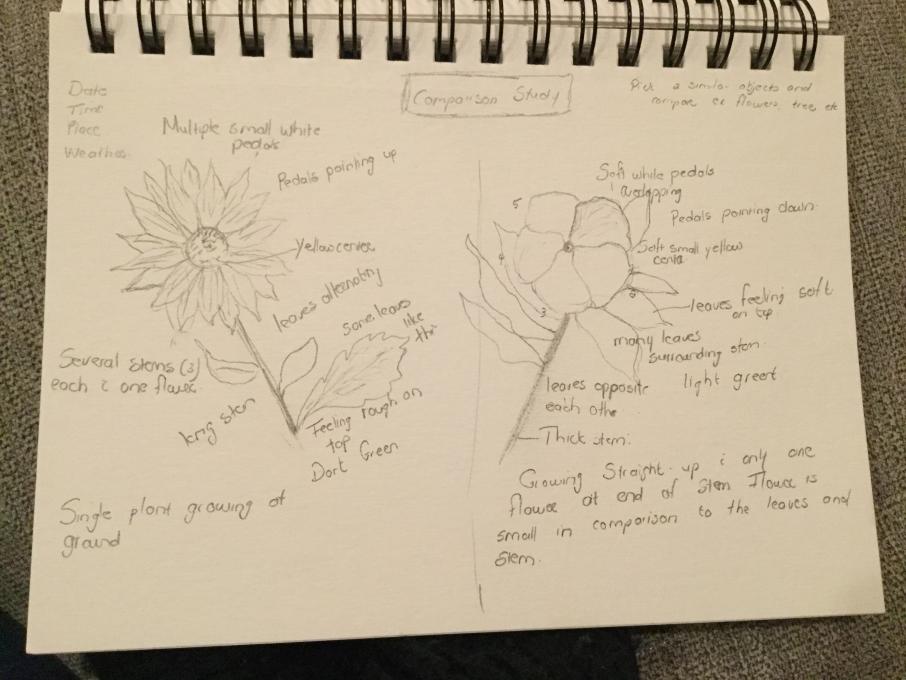
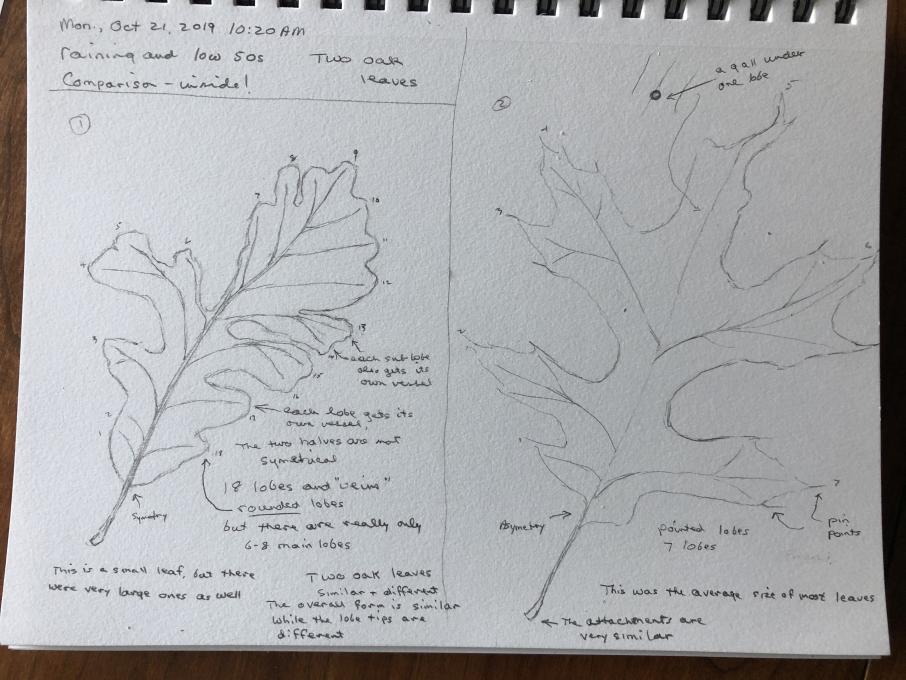 I
It rained most of today so I compared these two oak leaves working inside.
One new thing I learned is that not only each lobe had a vessel, but each sub-lobe had one as well. I wondered if the branched "veins" only carried sugars away from the leaf or if nutrients also flow back into the leaf. It seems there are these types of oak species (rounded or pointed lobes), and oaks with no lobes. The leaves reminded me of my own hand, especially the back.
I felt that I need to draw hundreds of leaves before I'll begin to appreciate the structure of leaves, and that's just the leaf! The whole tree. It's an endless journey.
The other student drawings are so interesting!
I
It rained most of today so I compared these two oak leaves working inside.
One new thing I learned is that not only each lobe had a vessel, but each sub-lobe had one as well. I wondered if the branched "veins" only carried sugars away from the leaf or if nutrients also flow back into the leaf. It seems there are these types of oak species (rounded or pointed lobes), and oaks with no lobes. The leaves reminded me of my own hand, especially the back.
I felt that I need to draw hundreds of leaves before I'll begin to appreciate the structure of leaves, and that's just the leaf! The whole tree. It's an endless journey.
The other student drawings are so interesting! 

 so I picked to do a comparison of the bark in the trunk area of a pine and oak .
so I picked to do a comparison of the bark in the trunk area of a pine and oak . 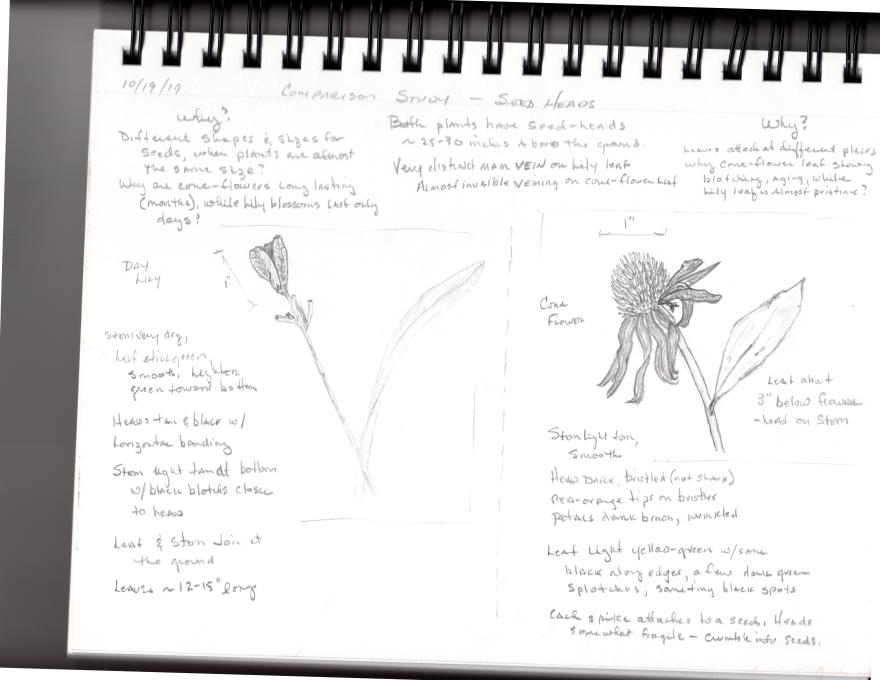 The weather has been too wet to go outside, so I collected these two seed-heads, and brought them inside. My handwriting doesn't make it easy... I suppose I need to remember how to print.
The weather has been too wet to go outside, so I collected these two seed-heads, and brought them inside. My handwriting doesn't make it easy... I suppose I need to remember how to print. 

 My plan when I went out this morning was to go to an area where I normally see a lot of songbirds and to compare the behavior of two species. Unfortunately just as I sat down, it got very windy and the birds all went wherever they go to get out of the wind. While sitting there I noticed a stand of three Aspen trees but one of the trees looked very different than the other two. Aspens usually do better at higher altitudes so it wasn’t surprising that one of them was diseased.
My plan when I went out this morning was to go to an area where I normally see a lot of songbirds and to compare the behavior of two species. Unfortunately just as I sat down, it got very windy and the birds all went wherever they go to get out of the wind. While sitting there I noticed a stand of three Aspen trees but one of the trees looked very different than the other two. Aspens usually do better at higher altitudes so it wasn’t surprising that one of them was diseased. 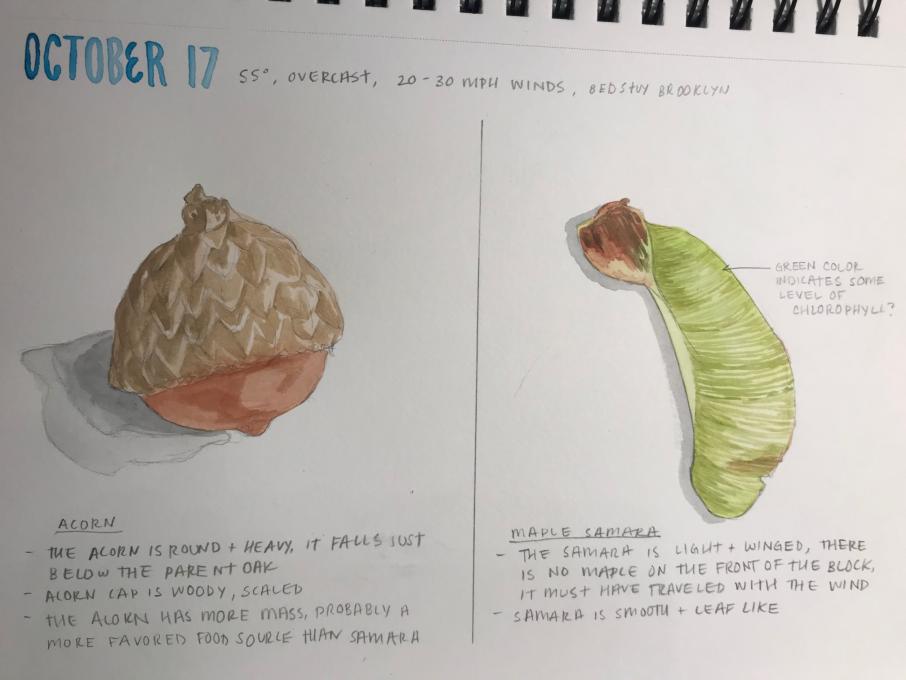 I did this exercise indoors because the weather was very bad today, I think my observation would have benefitted from being outdoors and also comparing leaves, branch and bark of the two trees. Now looking at other submissions I'd like to include scale measurements in upcoming drawings as well.
I did this exercise indoors because the weather was very bad today, I think my observation would have benefitted from being outdoors and also comparing leaves, branch and bark of the two trees. Now looking at other submissions I'd like to include scale measurements in upcoming drawings as well. 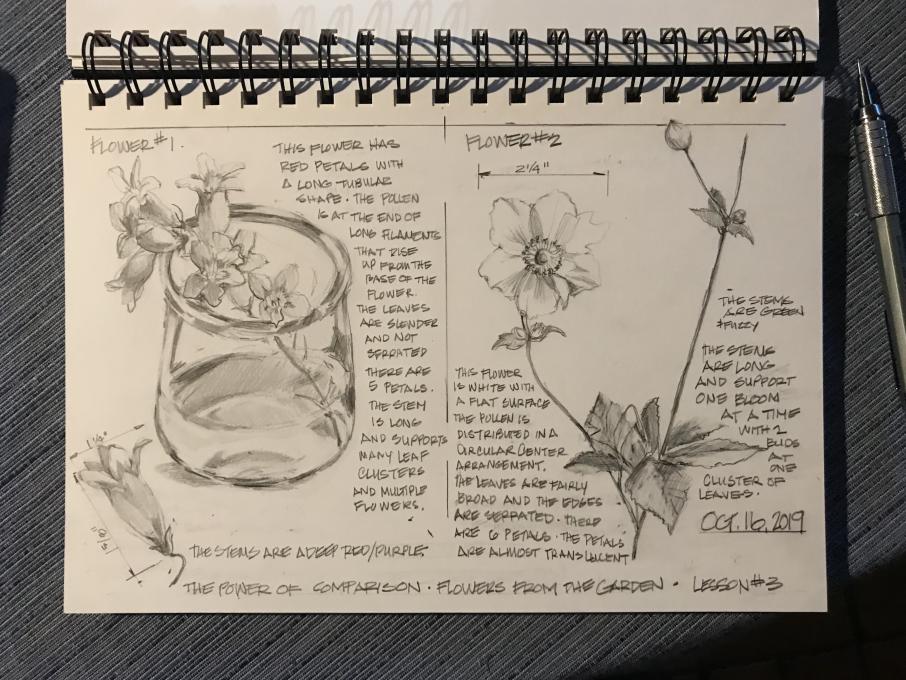

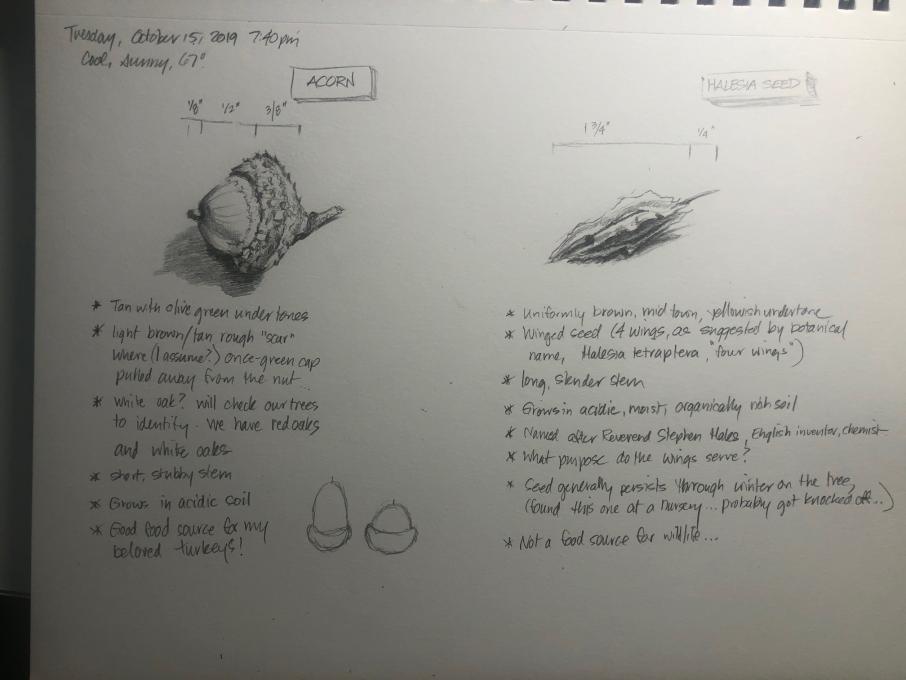 (it WAS sunny earlier today!
By the time I finished work, and cooking dinner, it was dark, so I used the acorn and Halesia seed I had collected a few weeks ago. The side by side comparison appeals to me, and urged me on to research the trees further. Didn't realized that Halesia seeds aren't a food source for wildlife, but did know that acorns are an important food source for turkeys and deer.
Have found no explanation for the wings of the Halesia's seed pods, made a note of my question for further research.
(it WAS sunny earlier today!
By the time I finished work, and cooking dinner, it was dark, so I used the acorn and Halesia seed I had collected a few weeks ago. The side by side comparison appeals to me, and urged me on to research the trees further. Didn't realized that Halesia seeds aren't a food source for wildlife, but did know that acorns are an important food source for turkeys and deer.
Have found no explanation for the wings of the Halesia's seed pods, made a note of my question for further research. 
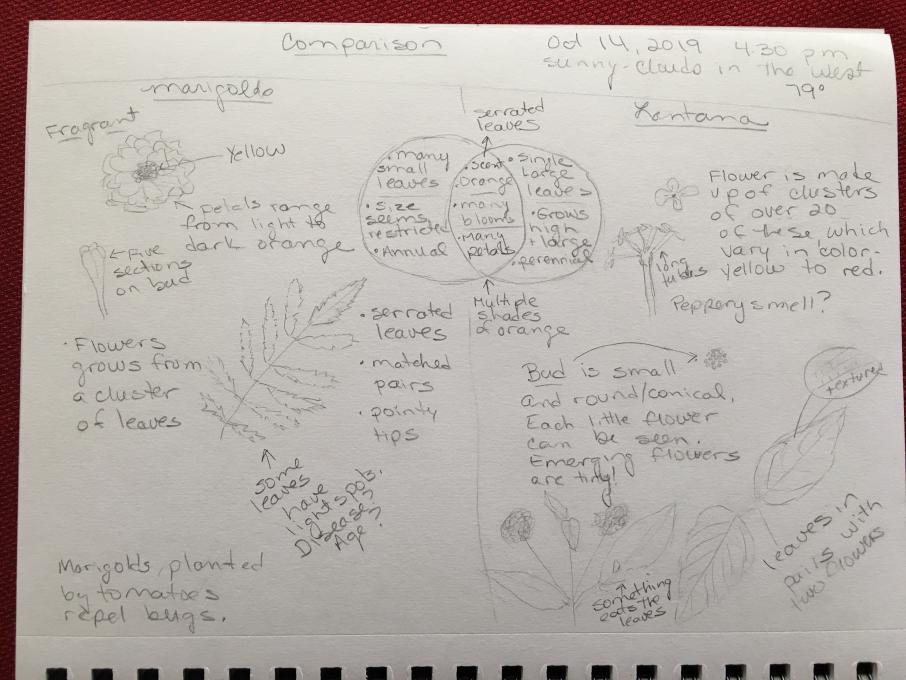
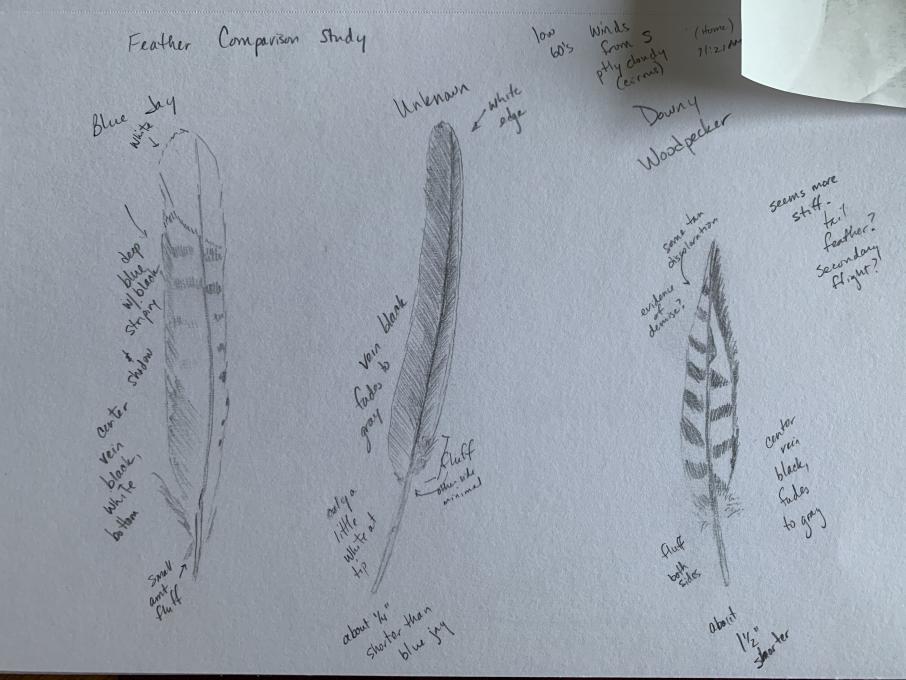 I compared these 3 discovered feathers. I know the Blue Jay and Downy Woodpecker, and not the middle, which was a very uniform gray with a white edge. It was about the same size as the jay, but more slender. The uniformity of color has me confused, Mockingbirds and Mourning Doves have patterns. This comparison study helped me to focus on feather length and detail. Another few questions I have is why do some birds appear to have more ‘fluff’ at the attachment end than others. Is the fluff related to their ability to keep warm in winter, thus not having to migrate?
I compared these 3 discovered feathers. I know the Blue Jay and Downy Woodpecker, and not the middle, which was a very uniform gray with a white edge. It was about the same size as the jay, but more slender. The uniformity of color has me confused, Mockingbirds and Mourning Doves have patterns. This comparison study helped me to focus on feather length and detail. Another few questions I have is why do some birds appear to have more ‘fluff’ at the attachment end than others. Is the fluff related to their ability to keep warm in winter, thus not having to migrate? 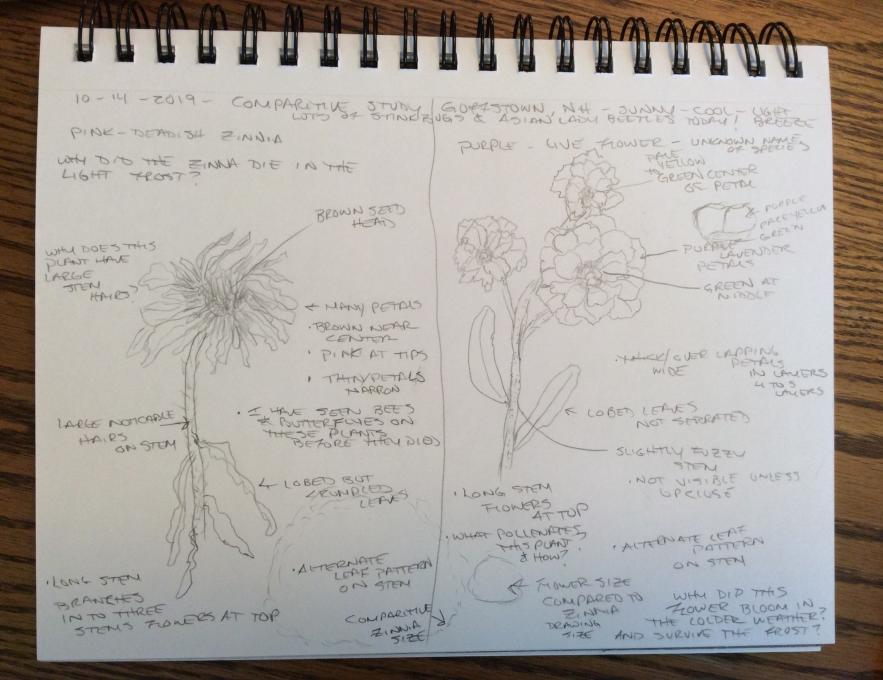 My comparative study is of a zinnia and another purple flower in my garden. The zinnias died back in the frost last weekend and the purple flower that I waited all summer to see blossom, popped into bloom with the frost.
I am now wondering what pollinates this flower and how it propagates itself, the flowers are in clusters at the top of the stem whereas the zinnia has a single flower at the end of the stem.
The stink bugs and Asian lady beetles were buzzing us the whole time we were out drawing...ahhh... Autum in New Hampshire, the foliage is awesome this year.
My comparative study is of a zinnia and another purple flower in my garden. The zinnias died back in the frost last weekend and the purple flower that I waited all summer to see blossom, popped into bloom with the frost.
I am now wondering what pollinates this flower and how it propagates itself, the flowers are in clusters at the top of the stem whereas the zinnia has a single flower at the end of the stem.
The stink bugs and Asian lady beetles were buzzing us the whole time we were out drawing...ahhh... Autum in New Hampshire, the foliage is awesome this year.

 I couldn’t find 2 lovely flowers, so I used 2 trees that were side by side—an oak and a cottonwood. It was almost like they were living in two different forests—the cottonwood was very flexible, blowing in the wind, with many of its leaves blown off. The oak barely moved in the wind, and still had most of its leaves. I found it challenging to suggest the texture of the two different trees without drawing individual leaves. I like having the inset single leaves; they make each of the trees more present to me.
The structure of the trees really varied. The oak had sturdy branches that reached up, and was dense with leaves. The cottonwood had fewer, more fluttery leaves, very responsive to the wind. Its branches drooped and swayed. I thought its wood is probably softer than the oak’s.
I couldn’t find 2 lovely flowers, so I used 2 trees that were side by side—an oak and a cottonwood. It was almost like they were living in two different forests—the cottonwood was very flexible, blowing in the wind, with many of its leaves blown off. The oak barely moved in the wind, and still had most of its leaves. I found it challenging to suggest the texture of the two different trees without drawing individual leaves. I like having the inset single leaves; they make each of the trees more present to me.
The structure of the trees really varied. The oak had sturdy branches that reached up, and was dense with leaves. The cottonwood had fewer, more fluttery leaves, very responsive to the wind. Its branches drooped and swayed. I thought its wood is probably softer than the oak’s. 